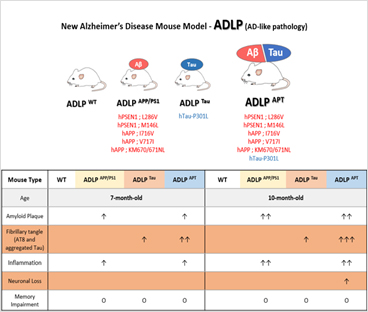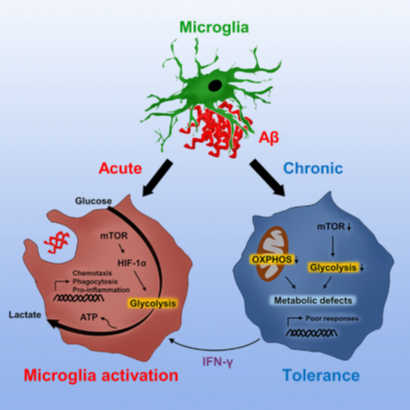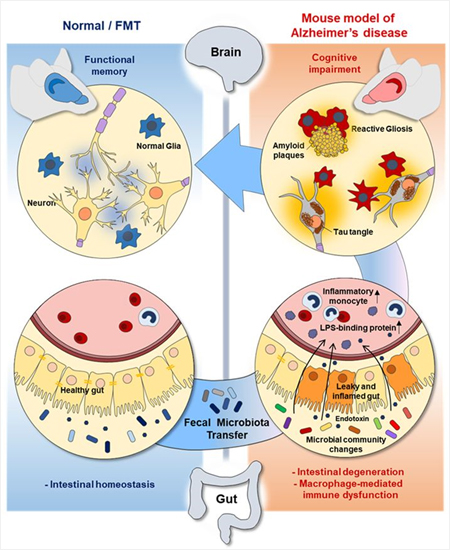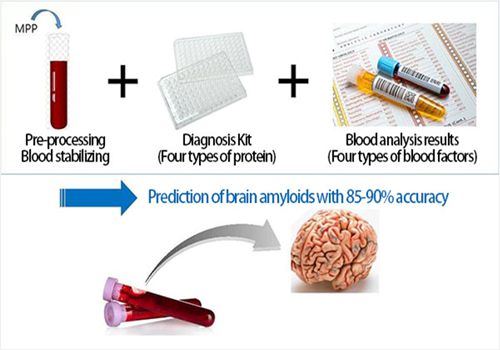SNU Dementia Research Center
Research & Members

 Research Fields
Research Fields
 Research & Members
Research & Members
Sources of dementia research knowledge and skills in SNUDRC
A variety of AD animal models
ADLPAPT: A mouse with both amyloid beta and tau proteins was newly developed by the team and was reported in an international journal (Mol Neurodegener. 2018). The new mouse model reproduces the pathological features of patients with Alzheimer's disease more closely than conventional mouse model does, making it suitable as a model for determining the cause of the disease (Figure 1).
 Figure 1
Figure 1
- Another mouse model, alongside ADLP mice, is also on its way through the mating of human APP KI mice and Tau KI mice, and will soon be used for mechanism studies.
- An animal model similar to the tau protein accumulation pathway in the actual patient's brain can be used to determine the cause of the transmission of tau protein, which is known to be highly correlated with cognitive impairment as the disease progresses and is currently being studied. In addition, correlation between tau proteins and amyloid beta can also be studied.
- By having an animal model that imitates actual patient’s pathway of how tau proteins accumulate, it is possible to investigate the causes of tau protein propagation, which highly correlates with cognitive decline, and is currently under research.
Confirmation of therapeutic effect through mechanism study of microglial function.
- Although the function of microglia is well known, how microglia control immune functions and the reasons of their breakdown in the Alzheimer’s disease was not clear. Recently, our research team has identified and reported the detailed mechanism (Cell Metab. 2019).
- The study identified that the metabolic (responsive, oxidative oxidation) conversion of microglia is important for immune function, suggesting a new paradigm for the regulation of microglial function (Figure 2).
- In addition, animal models have demonstrated the effect of restoring ability to remove toxic proteins, beta amyloid, and improving cognitive function by metabolic boosting of microglial function with interferon gamma. This result suggests a new therapeutic approach to Alzheimer's disease through the promotion of microglia metabolism
 Figure 2
Figure 2
Technology on gut-brain axis research
- Our research group has recently reported that gut microbiota is closely related to Alzheimer’s disease (Gut, 2020). We have confirmed that memory and cognitive impairment were rescued when healthy fecal microbiota from normal mice was transplanted to disease model mice, thereby inducing changes in gut microbiota and gut environment (refer to Fig. 3. Fecal microbiota transplant (FMT) technology for animal models was also developed.
- At present, the generation of Alzheimer’s disease patient-derived gut organoid is in progress.
 Figure 3
Figure 3
Technology using plasma for early diagnosis of dementia
- Our research group has invented a method to stably measure beta-amyloid protein level in plasma by treating plasma with novel pre-treatment material (MPP) to inhibit various proteases that exist within (Fig. 4). The commercialization of a detection kit that utilizes this method for early diagnosis of Alzheimer’s disease is currently being promoted
- Blood pre-processing technology and research contents on recently discovered biomarkers were also reported on international journals (Alzheimers Res Ther. 2017, Prog Neurobiol. 2019).
Establishment of normal and patient-derived brain organoids
- Generation of induced pluripotent stem cells (iPSCs) from cognitively normal individuals and patients with AD (Fig. 4.)
- Generation of normal/AD organoids and establishment of the organoid disease model, thereby developing a personalized drug screening platform
 Figure 4
Figure 4
QUICK MENU
TOP

